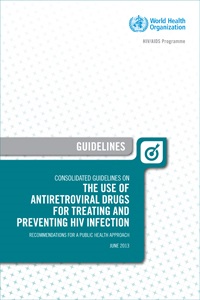Consolidated guidelines on the use of antiretroviral drugs for treating and preventing HIV infection (2013)
Recommendations for a public health approach

Overview
WHO first published guidelines on the use of ART for HIV infection among adults and adolescents in 2002 and on the use of ARV drugs for PMTCT in 2004. The 2006 updates of the guidelines introduced the concept of a public health approach, with simplified and harmonized ART regimens. These publications and their updates, in 2010, have provided important guidance to countries that have scaled up national ARV programmes during the past decade. In 2013, for the first time, WHO has revised and combined these and other ARV-related guidance documents into one set of consolidated guidelines that addresses the use of ARV drugs for HIV treatment and prevention across all age groups and populations, based on the broad continuum of HIV care.
These guidelines were updated in late 2012 and early 2013. The ARV regimens now available, even in the poorest countries, are safer, simpler, more efficacious and more affordable than ever before. New testing strategies and approaches are enabling earlier diagnosis of HIV in a wider range of settings, and new, more affordable technologies for monitoring people receiving ART are becoming available. Countries are moving towards triple-drug regimens and simplified programming for PMTCT that emphasizes the long-term health of pregnant women and mothers living with HIV as well as their children. Important new evidence has shown that ARV drugs offer significant benefits in preventing HIV transmission. Although countries are at different stages of ART coverage and implementation of the 2010 guidelines and there are still important gaps in research, there is a consistent global trend towards expanding access and the earlier initiation of treatment.
